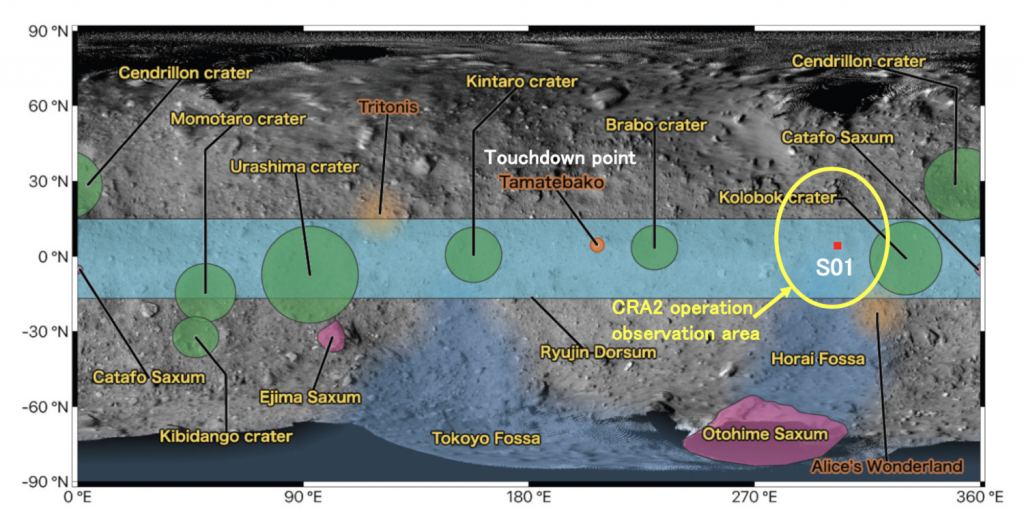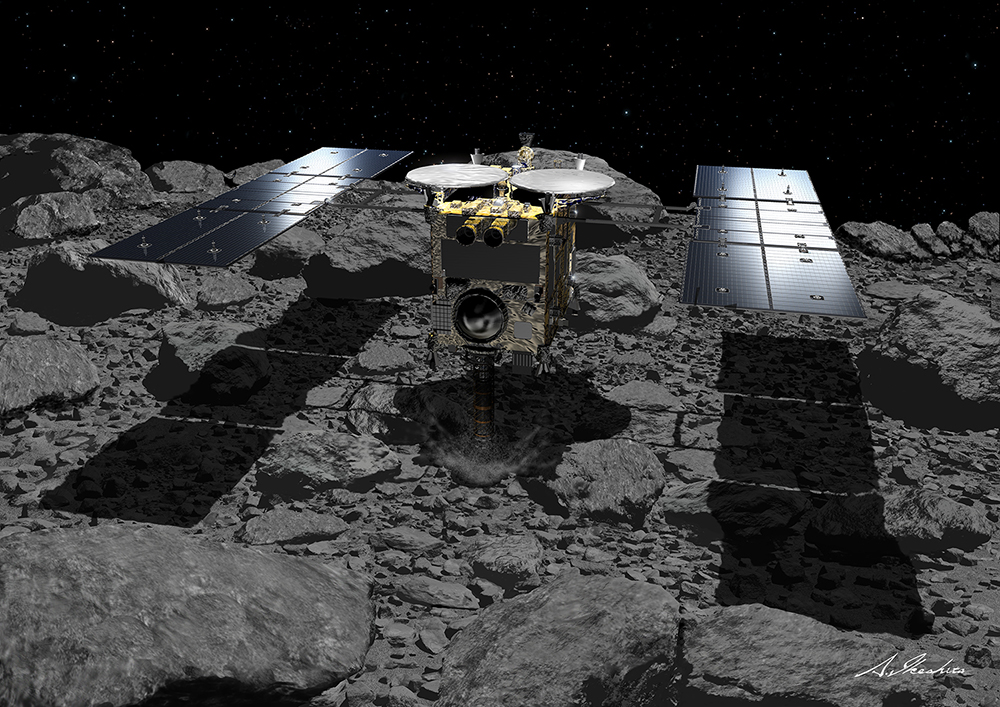As part of its mission to explore the Near-Earth Asteroid (NEA)
162173 Ryugu, the Japan Aerospace Exploration Agency‘s (JAXA) Hayabusa2 spacecraft recently dropped a “bomb” on the asteroid’s surface. This explosive package, known as the Small Carry-on Impactor (SCI), was specifically designed to create a crater in the surface, thus exposing the interior for analysis.
The deployment of the SCI took place on April 5th, exactly six weeks after the spacecraft collected its first sample from the surface. Last Sunday, (April 21st, 2019), JAXA provided the video of the “bombing run” via the mission’s official twitter account. This was followed four days later by images of the crater that resulted, which revealed darker material from the interior that was now exposed to space.
The SCI operation consisted of a 2.5 kg (5.5 lbs) copper plate being accelerated by a shaped-charge of 4.5 kg (~10 lbs) of plasticized HMX explosive (aka. octogen) – used in military-grade weapons and munitions. The plate then collided with the surface, releasing a cloud of regolith that was then photographed by the spacecraft’s deployable camera (DCAM3) – which was destroyed in the process.
The video provided in the tweet (shown above) was composed of images taken by the spacecraft’s Thermal Infrared Camera (TRI), which show the SCI moving towards the surface shortly after it separated from the spacecraft. With the SCI operation complete, the mission team began moving onto the next phase of the spacecraft’s operations.
This next phase – Crater Search Operation 2 (CRA2) – began on April 23rd, when the team began making preparations to descend towards the surface again. The descent began on the following day, and by April 25th, the spacecraft reached its lowest altitude of 1.7 km (1.05 mi). Once there, it conducted observations of the crater to see what the impact had turned up.
This is the same region that the spacecraft observed during its last observation run (dubbed CRA1), which took place from March 20th to 22nd, before the deployment of the SCI. Once the observations were complete, JAXA tweeted images from both CRA1 and CRA2 to provide a before and after comparison of the surface.
As you can see, the explosion moved some larger chunks of material out of the way and left a decent-sized crater. It also exposed a patch of regolith that is noticeably darker than what was on the surface. In this respect, the SCI fulfilled its purpose, which was to break up the surface so that regolith from the interior could be analyzed.
This is similar to the process the mission team has used to obtain samples of material from the surface. Before descending to collect regolith with its sampling horn, the spacecraft breaks up the surface by hitting it with 5-gram tantalum impactors (aka. “bullets“) at speeds of 300 m/s (1080 km/h; 670 mph).
The purpose of this is to determine the composition of an asteroid to gain insight into the earliest period of our Solar System. According to the current scientific consensus, asteroids like Ryugu are composed of material left over from the formation of the planets, ca. 4.5 billion years ago. Samples obtained from the asteroid’s interior are preferred, since they have not been exposed to vacuum and solar radiation for billions of years.

What’s more, scientists believe that water and organic materials were distributed by asteroids during one of the earlier periods of the Solar System, known as the Late Heavy Bombardment period (ca. 4.1 to 3.8 billion years ago). The study of these materials is therefore expected to shed light on how water and organic materials were initially distributed throughout our Solar System.
In turn, this information could go a long way towards informing our theories about how and possibly where (i.e. other than Earth) life could have emerged.
Further Reading: JAXA

